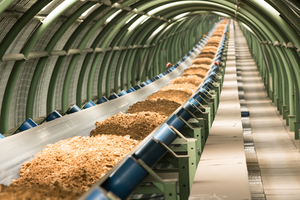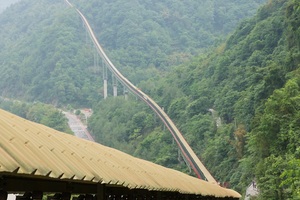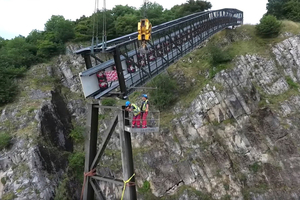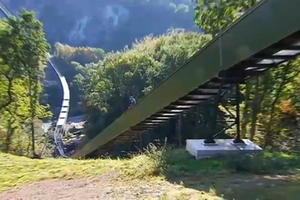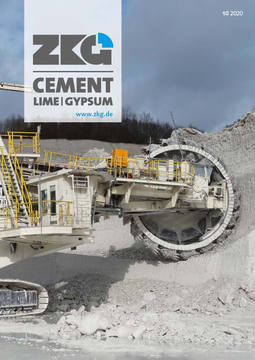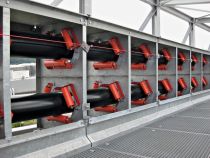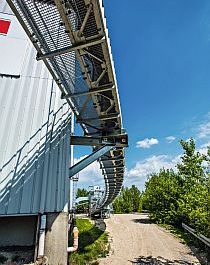Belt conveyors instead of trucks – an efficient alternative?
Recovered raw materials have to be transported from the quarry to the factory or port, often over uneven ground and across populated areas. Companies often choose trucks for transportation. As an alternative, system suppliers including Beumer Group offer open troughed belt conveyors or closed pipe conveyors. These solutions are more environmentally friendly and can be considerably more economical. Deciding if the investment is worthwhile depends on several factors. A feasibility study and a cost comparison can help with the decision.
Companies often choose trucks to transport limestone, coal ores and other raw materials as efficiently as possible to the factory and from there to the port, sometimes over distances spanning several kilometres. Most of the time, the vehicles drive on public roads, which are not always well-paved. And as the route can go through hilly areas and nature reserves, across rivers and unstable ground, the trip often includes detours which costs time and money. If it goes through populated areas, it can be particularly taxing for local residents. The more raw materials are transported, the more trips are necessary. These factors motivate companies to take a closer look at the alternatives. Beumer Group offers open troughed belt conveyors and closed pipe conveyors for these scenarios. But will the investment pay off? “That depends on the particular application,” says Richard Munson. He has been with Beumer Group in Kansas City, Missouri, since 2010 where he manages the development and sales of conveying systems for the energy, cement and mining industries and port terminals. “Companies should carry out a profitability evaluation beforehand,” he advises.
An economic evaluation pays off
There are different methods to run an economic evaluation, including the net present value method, which is a type of profitability calculation. “Simply put, it means that all future income is discounted to time zero and compared, including the initial investment,” explains Munson. This method uses a calculation interest rate that reflects the best available alternative investment. The user receives a capital value, also called net present value or NPV. If this value is positive, it means that the company will make a profit with the investment.
“Another option is cashflow analysis. It estimates the surplus that remains when deducting expenses from earnings,” Munson explains. Based on the annual difference of the total operational costs between conveying and trucking, the user calculates whether investing in a conveying system will pay off. Different variables are required to exactly evaluate both transport options, for example the transport costs per ton, the material volume that needs to be moved within a set period of time, and also the specific investment cost and tax depreciation plan. “A comparison of conveying and trucking in a time diagram results in the break-even point,” explains the Beumer expert.
Cost comparison
Depending on the topography, length and power consumption, costs for conventional conveying systems average between € 1000 and 3000 per metre. More costs are added for the construction, supply and the mechanical and electrical installation. Complex construction work is also often necessary. This makes the initial investment in a conveying system fairly high. “The operational costs however are considerably lower than with the use of trucks,” reports Munson. “The costs for the vehicles also include the labour input, vehicle depreciation, maintenance, repair, fuel and street maintenance for example. And oftentimes there are additional, more difficult to identify charges.”
To operate a conventional conveying system, the typical costs for transporting one ton of material amounts to 20 Cents, with trucks the costs are roughly three Euro. “The biggest variable for the vehicles is the number of trips per hour,” says Munson. “In case of short and direct routes, this ranks better than for long routes, where detours are necessary to get to the destination.” Troughed belt conveyors and closed pipe conveyors lead directly to the destination. They can also be adapted to the specific surroundings. An essential feature of the technology is that it enables horizontal and vertical curves. Angles of inclination of up to 15 degrees are possible, depending on the characteristics of the material to be transported and the topography, with lengths greater than twelve kilometres. Due to their ability to navigate curves, considerably fewer and in some cases no transfer towers are required. This results in substantial cost savings for the customer and the system continuously transports the material even over challenging ascending and descending sections, rivers or street crossings. Using Beumer calculation programs, the experts precisely calculate the static and dynamic tractive forces of the belt during the system development phase. This is the prerequisite for the safe dimensioning of the curves.
For trucks, more cost factors must be taken into account that are not as easy to estimate as the number of routes: control measures against dust and rain drainage, for example. These variables are eliminated completely in the case of closed pipe conveyors. “If circa 1 000 000 t of bulk material are moved per year, then the gross differential value between trucks and a conveyor, using the above-mentioned costs of the material that needs to be conveyed, is at € 2.8 million,” calculates Munson. That is quite a number, in his opinion. The conveying system pays for itself after only a few years.
Ecological and economical
The electric drives and low-energy belts have a positive effect on the operational costs of the belt conveying systems. They are also better for the environment compared to the truck drives. Therefore, especially in these times of climate change and increasing greenhouse gas emissions they are considered a more sustainable option. The motors used for these systems are usually adjustable which permits the loads to be optimally distributed on the drive units under various operating conditions. If the belt conveying system conveys downhill, the system works in regenerative operation. The generated electric energy is fed to the mains by a regenerative feedback unit. This way the owners can further reduce the operational costs of the entire system.
“Depending on the project, belt conveying systems require up to 90 % less primary energy than comparable truck transports,” says the sales manager, referring to a concrete project implemented for the Chinese cement manufacturer Sichuan Yadong Cement. Trucks operated with diesel fuel required a specific primary energy of 11.4 kwh for each ton of transported material at their site. The belt conveying system which was built later required on the contrary only 1.44 kwh. If, as in this case, 7.5 million t of raw material are transported annually, the user can save a total of 74 million kwh per year with the belt conveyor. This corresponds to an energy consumption of more than 20000 single-family houses. Solely by saving diesel fuel, the operational costs of the company are reduced by more than € 5.5 million per year.
So does the investment in a belt conveying system pay off? “More often than people realise,” explains Munson. “In the end, the operator needs to consider the total costs per ton over time when evaluating both transport options.” The fact is: The operational costs for a belt conveyor are considerably lower than for a truck. The decisive factor is how much material is transported during the project term, then it can pay for itself quickly. Not to mention that the Beumer conveying systems are more environmentally friendly from the beginning.
//www.beumer.com" target="_blank" >www.beumer.com:www.beumer.com

